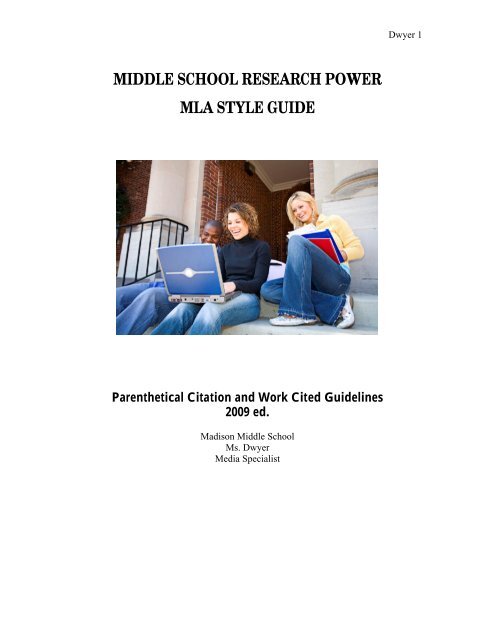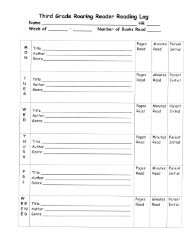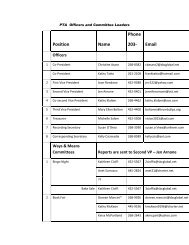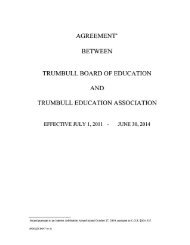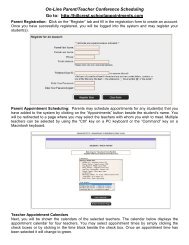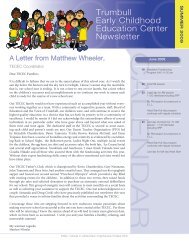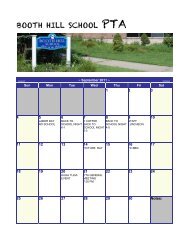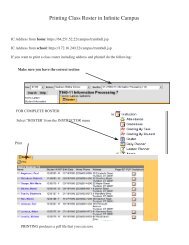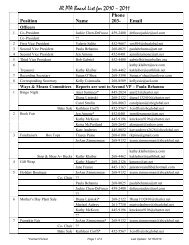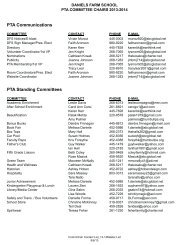middle school research power mla style guide - Trumbull Public ...
middle school research power mla style guide - Trumbull Public ...
middle school research power mla style guide - Trumbull Public ...
You also want an ePaper? Increase the reach of your titles
YUMPU automatically turns print PDFs into web optimized ePapers that Google loves.
Dwyer 1MIDDLE SCHOOL RESEARCH POWERMLA STYLE GUIDEParenthetical Citation and Work Cited Guidelines2009 ed.Madison Middle SchoolMs. DwyerMedia Specialist
(hold)Dwyer 2
Dwyer 3Introduction: What is Academic Honesty?The purpose of this handbook is to foster academic honesty. This <strong>guide</strong> will make citing(giving credit to) your sources simple. If you write a paper (it does not matter which kind)and you take information from a place OUTSIDE OF YOURSELF you must add an in-text,or parenthetical, citation. This tells the reader that the information he just read did not comefrom you. If you do not do this, you have not been honest and have plagiarized. Plagiarismis defined as "the act of representing the work, words, images, data or ideas of others as yourown without properly citing the source" (<strong>Trumbull</strong> High School: Academic Honesty 2008-2009 ).To stay honest, you will be using the standard devised by the Modern Language Association(MLA) to cite sources. This booklet will go over MLA format and explain parentheticalcitations and works cited pages.
Dwyer 4Rules of Research‣ If you use anything that comes from outside of you (an idea, music, art,photograph, words, <strong>research</strong>, etc.) you mist cite it.‣ When in doubt, cite it!‣ Both direct quotes (words copied from text) and paraphrased information(information that you have put into your own words) must get an in-text, orparenthetical, citation.‣ If you have citations in your paper, you must include a Works Cited page as thelast page of your paper.‣ Absolutely do not make up sources, quotes, data, citations or anything else!
Dwyer 5Parenthetical (In-text) CitationWhat is Parenthetical Citation?Parenthetical citation is when a writer directly puts into the text a note from where he orshe got the information. Parenthetical or “in-text” citation allows your reader to knowfrom what source each idea/fact came. This is how it looks in the text of your paper:“In 2007, 37 percent of American adults sought medical information from theinternet regarding a health problem they were experiencing before consultinga doctor” (Smith 38).In the example above, notice that the author’s name and the page number on which thisfact was found are set off from the text within parenthesis. Note also that the punctuationof this parenthetical citation is also important. The end punctuation is not inside thequote, but outside of the parenthesis. Furthermore, since the words are contained withinquotes, the above example illustrates that this is a direct quote from that page.Here is an example of the same idea presented as an indirect quote:Instead of going to a doctor right away, a recent study found that 37 percent ofAmericans are now turning to the internet for medical information (Smith 38).Costello, Kevin. MLA Style Guide for Middle School. Oct. 2008. Lakewood City Schools. 3 February 2009.It is imperative to understand that paraphrased information orindirect quotes must also be cited! If paraphrased information is notcited, it is considered plagiarism.
Dwyer 6EVERYTHING YOU NEED TO KNOW ABOUT AWORKS CITED PAGE1. A works cited page lists all of the sources used in your paper. It includes allpublication information about each source. This is mandatory because readers willwant to explore the sources used to further their own learning.2. Alphabetize entries in the list of works cited by the author’s last name. If theauthor’s last name is unknown, alphabetize by title, ignoring any initial A, Anor The.3. DO NOT number entries.4. Begin list of works cited on a new page and DO NOT number it as your firstpage. Your works cited will be consecutively numbered with your <strong>research</strong> paper(if your paper ends on page five, your works cited will begin on page six).5. Use 1” margins and center the title Works Cited. DO NOT bold, underline,capitalize every letter or italicize the words Works Cited. Font size must be 12 pt.6. The Works Cited page must be double spaced.7. Begin the first line of each entry flush left. Keep typing until you run out of roomat the end of the line. Indent the second line 5 spaces and all subsequent lines ofthe same entry. Double space all lines, both within and between entries.8. Following are different sources and how they should be referenced in your WorksCited.9. A model works cited list is provided on the last page of this booklet.
Dwyer 7Examples of Common Forms of Sources for Citation**NOTE** The details are important in these citations--the order of the information, punctuation,underlining and quote marks all must be exact.Print Resources (Viewed in Print Form)Book by One AuthorAuthor Last Name, First Name. Title. Place of publication: Publisher, Copyright Date.Example:Jameson, George P. Ellis Island. New York: Icon Press, 2006.Book by Two (or Three) AuthorsAuthor Last Name, First Name and Second Author First Name Last Name. Title. Place ofExample:publication: Publisher, Copyright Date.Smith, Henry G. and Betty Harmon. Freedom Rides. Chicago: BroadShoulder Press, 2006.If there are more than three authors, you may name only the first and add et al. or youmay give all names in full in the order in which they appear on the title page.Quirk, Randolph, et al. A Comprehensive Grammar of the English Language. London:EncyclopediaLongman, 1986.(NOTE: The author is usually listed at the end of the article. If an author is not listed, begin the entrywith the title of the article. Do not cite editor.)Author Last Name, First Name. “Title of Article.” Name of Encyclopedia. Edition number. Year.Example:Franz, Charlene. “Goat.” World Book. 2 nd ed. 2006.
Dwyer 8A Work within an AnthologyLast Name, First Name. “Title of work.” Title of Anthology. Editor’s First NameLast Name. Place of <strong>Public</strong>ation: Publisher, Copyright Date. Page numbers.Example:Stevens, Wallace. “Sunday Morning.” Modern American Poetry. Ed. Thomas J.Hines. New York: Holt, Rinehart and Winston, 2003. 20-22.Newspaper ArticleAuthor Last Name, First Name. “Title of Article.” Newspaper Name Date: page(s).Example:Blake, Terry. “Attack in Bagdad: Two Marines Dead.” The Plain Dealer 20 July2006: A1.Magazine ArticleAuthor Last Name, First Name. “Title of Article.” Title of Magazine Date: page numbers.Example:Thomasson, Ronald. “Salt Mines of Lake Erie.” Cleveland Magazine 15 May 2004:23-25.Non-Print Resources (Viewed Electronically)Online Database—EncyclopediaAuthor Last Name, First Name (if listed.) “Title of Article.” Title of site. Date of publication orupdate. Name of sponsoring institution. Date accessed .Example:“Whale Oil.” Encyclopedia Britannica Online. 2006. Encyclopedia Britannica. 23August 2006 .
Dwyer 9Online DatabasesLast Name, First Name. “Title of Article.” Original Print Source Title. Date. Onlinesource name. Date accessed .Example:Freeman, Gregory A. “Code Alpha: The President is Coming!” American History.October 2006. Academic Search Premier. 6 October 2006.Internet WebsiteAuthor Last Name, First Name (if given). “Article Title.” Name of Website. Date last updated. Nameof organization that sponsors the site. Date accessed .Examples:Walker, Gary. “The Effects of Radiation.” U.S. NRC. 15 Mar. 2000. United States NuclearRegulatory Commission. 14 Oct. 2008 .InterviewInterviewee last name, first name. Personal Interview. Date of interview.Raymond, Raja. Personal interview. 6 Feb. 2007.
Dwyer 10Works CitedBradley, Ann. “Educated Consumers.” Education Week on the Web. 26 Mar. 1997. 4Apr. 1998 .“DNA.” Encyclopedia Americana. 1994 ed.Gershman, Herbert S. The Surrealist Revolution in France. Ann Arbor: U of Michigan,1994.Handbook of Pre-Columbian Art. New York: Johnson, 1988.Kuhn, Susan. “A New Stick Play in Savings and Loans.” Fortune 15 May 1995: 67-72.“Making of a Candidate for President.” Time 20 July 1984: 40-42.May, Clifford. “Religious Frictions Heat Up in Rwanda.” New York Times 12 Aug.1994, late ed.:A1.Melville, Herman. Moby Dick. Ed. J.P. Small. Boston: Houghton, 1973.Paine, Thomas. The Rights of Man. 1972. 12 Apr 1998 .Poe, Edgar Allen. “The Raven.” Great American Poetry. Ed. Richard Johnson. NewYork. McGraw, 1978. 38-40.Raffer, Bernard and Richard Freidman. New York in Crisis. New York: Harper, 1986.Smith, Richard. “Color and Light.” Encyclopedia Britannica. 1994 ed.Thomson, Dick. “Rendezvous for Old Rivals.” Time. 27 Mar. 1995. 20 Apr. 1998.


